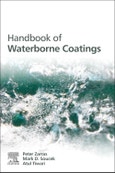Handbook of Waterborne Coatings comprehensively reviews recent developments in the field of waterborne coatings. Crucial aspects associated with coating research are presented, with close attention paid to the essential aspects that are necessary to understand the properties of novel materials and their use in coating materials. The work introduces the reader to progress in the field, also outlining applications, methods and techniques of synthesis and characterization that are demonstrated throughout. In addition, insights into ongoing research, current trends and challenges are previewed. Topics chosen ensure that new scholars or advanced learners will find the book an essential resource.
Please Note: This is an On Demand product, delivery may take up to 11 working days after payment has been received.
Table of Contents
1. Water-based Sol-Gel Coatings for Military Coating Applications2. Water-dispersible Conductive Polymers for Applications as Smart Coating3. Photocatalytic waterborne coatings4. Research Progress of waterborne anti-corrosion coatings based on conducting polymers5. Electrodeposition of waterborne coatings on the polymer component6. Additive technologies in water borne coatings7. Nanostructured waterborne acrylic coatings: Thermo-mechanical properties enhancement by molecular jamming and confinement8. Low VOC coalescent formulations in waterborne coatings9. Dispersion and dispersion Stability of Graphene in Aqueous media for waterborne coating application10. Waterborne polyurethanes from castor oil-recycled polyols11. Waterborne resins for long open time applications12. Biodeterioration of waterborne coatings13. Waterborne cathodic electrocoatings for automotive applications14. Waterborne coatings from biobased monomers15. Waterborne superhydrophobic coatings for the conservation of the cultural heritage: a case study for the protection of mortar, ceramic and wood16. Waterborne polyurethanes and their nanoparticle containing dispersions/coating17. Waterborne Coatings with Natural Preservative as Bio-Protective for Wood and Cellulose Products18. Corrosion protection by waterborne acrylics DTM (direct to metal) paint system doped or not with encapsulated corrosion inhibitors19. Waterborne polyurethane vegetable oil-based coatings20. Commercial Waterborne Coatings








